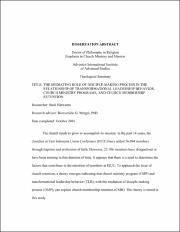The Mediating role of disciple-making process in the relationship of transformational leadership behavior, church ministry programs and church membership retention
Abstract
The church needs to grow to accomplish its mission. In the past 14 years, the
churches at East Indonesia Union Conference (EIUC) have added 56,984 members
through baptism and profession of faith. However, 23,106 members have dropped out or
have been missing in that duration of time. It appears that there is a need to determine the
factors that contribute in the retention of members at EIUC. To approach the issue of
church retention, a theory emerges indicating that church ministry program (CMP) and
transformational leadership behavior (TLB), with the mediation of disciple-making
process (DMP), can explain church membership retention (CMR). This theory is tested in
this study.
This study employed a correlation method with Structural Equation Modeling
(SEM). The study used a self-designed questionnaire validated by the panel of experts
and piloted to determine their reliability. Using convenience sampling, the 525
respondents were chosen to represent the members of EIUC churches. The study
determined the perceptions of the respondents on the extent of CMP, TLB, DMP and
CMR dimensions. The predictive variables were also considered to determine the
contribution of CMP, TLB, DMP, and demographic variables to CMR. Lastly, the
mediating role of DMP was taken to establish the model for CMR using SEM.
Using descriptive statistics, the results show that CMP, TLB, and DMP are very
highly practiced while CMR has very high retention. However, some dimensions in some
variables have a lower rating such as individual consideration for CMP, involving for
TLB, and behavior for DMP. Using Pearson’s correlation, the result shows a positive and
significant relationship among CMP, TLB, DMP, and CMR. Using multiple regression
analysis, the result shows that CMP (evangelism, worship service, and fellowship), TLB
(inspirational motivation and intellectual stimulation), DMP (calling, integrating,
equipping, and involving), and demographic variables (members’ involvement and their
number of friends) help predict or explain the variance in CMR. Using SEM, the result
shows that DMP significantly and positively mediate the relationship of CMP and TLB to
CMR.
To implement the CMR model, an integrated membership retention program
(IMRP) is developed as a proposal to the context of EIUC. IMRP uses the variables in
CMP, TLB, DMP, and CMR to guide in the design and implementation of the program.
Biblical-theological, theoretical, and contextual principles are also incorporated to make
the program responsive to the needs of the church leaders and members. On the basis of
the foundation of IMRP, the different needs of church members can be met, thereby
addressing if not eliminating the challenges in church retention issues at EIUC.


